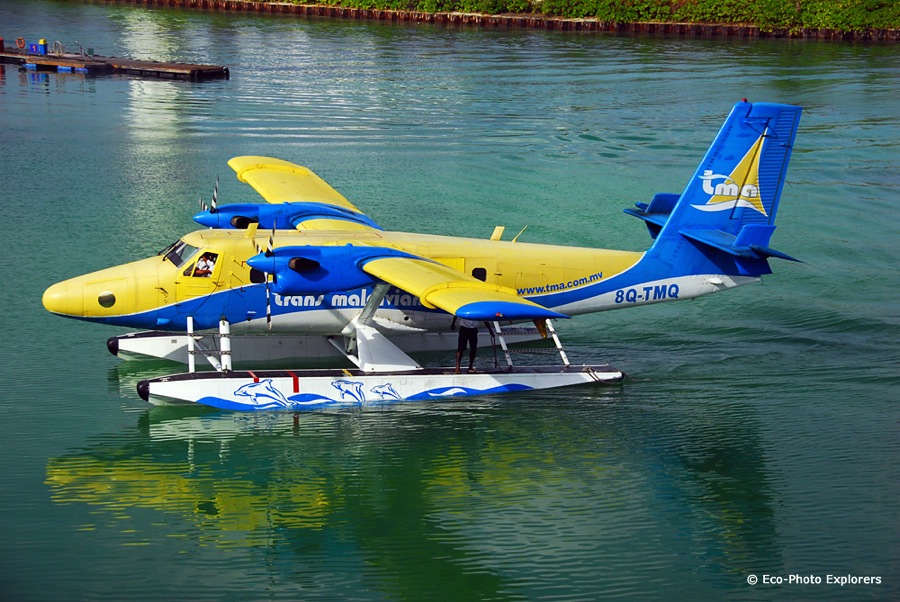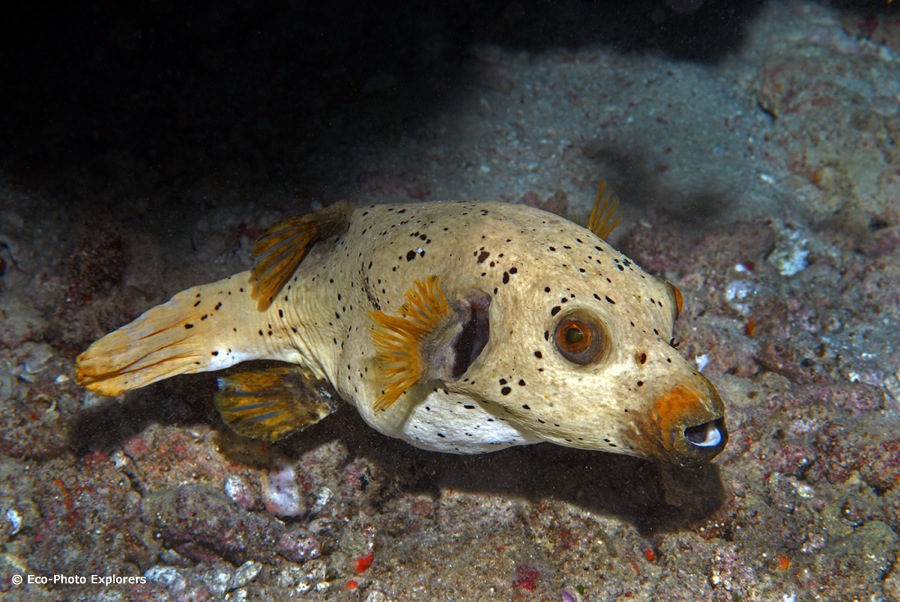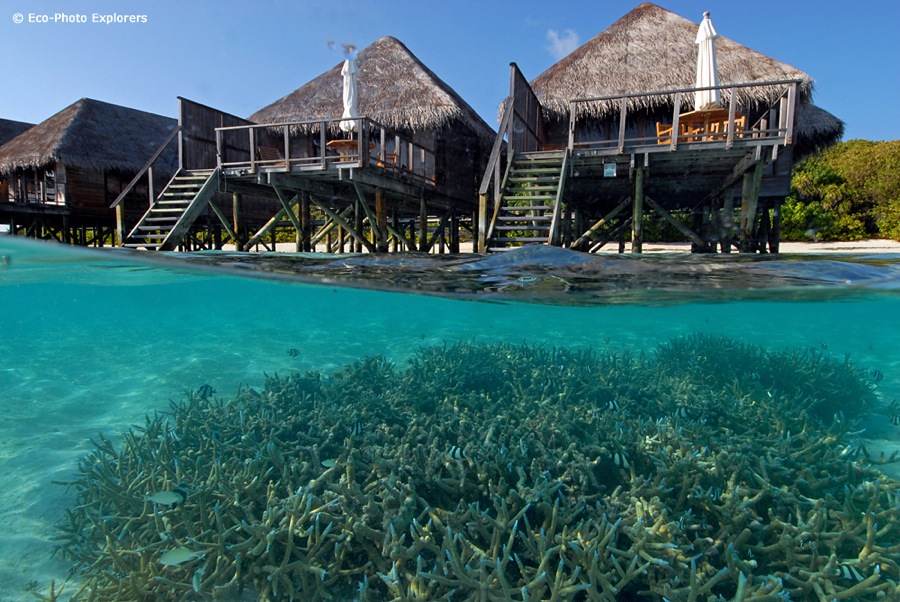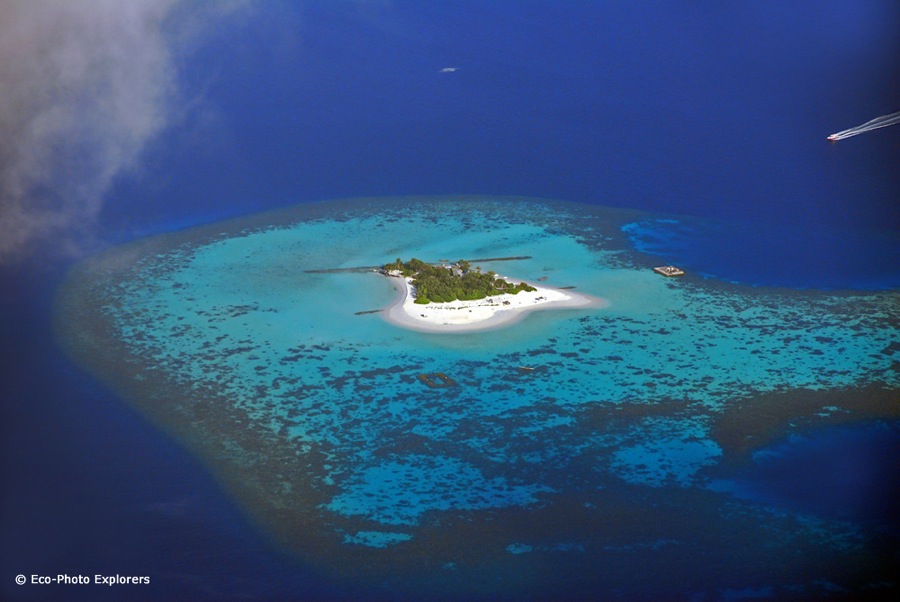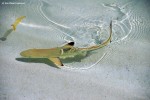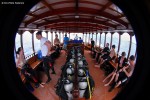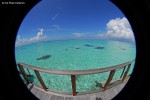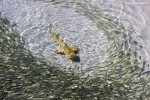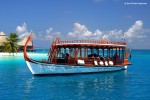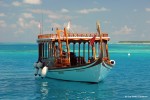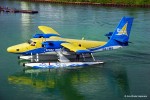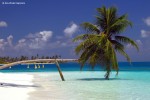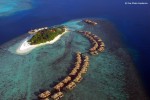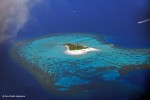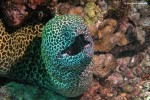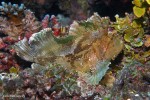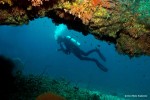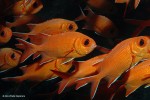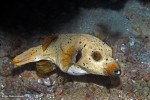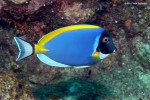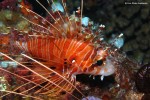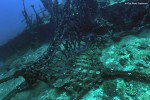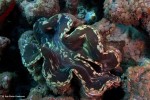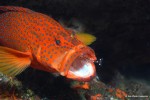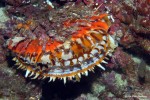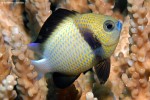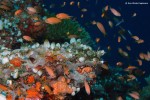The fantasy of being stranded on a remote island in the middle of nowhere far removed from the hustle and bustle of everyday life was shattered when the Blackberry began buzzing almost immediately upon landing at the dock of Rangali Island, a tiny outpost in the Maldives’ Ari Atoll. Yes, Rangali is home to the plush and luxurious Conrad Resort but, still, is there no escape from email and text messages and…well, civilization?
A furtive glance at the Blackberry screen confirmed it: yup, there was an email from the boss.
Well, that is what the “on/off” switch is for, right?
The Maldives have long been a destination on the top of many scuba diver “bucket lists” and for good reason. With picture perfect lagoons, brilliant white sand beaches, swaying palm trees and colorful coral reefs teeming with life, the Maldives hold an allure of visiting a living postcard.
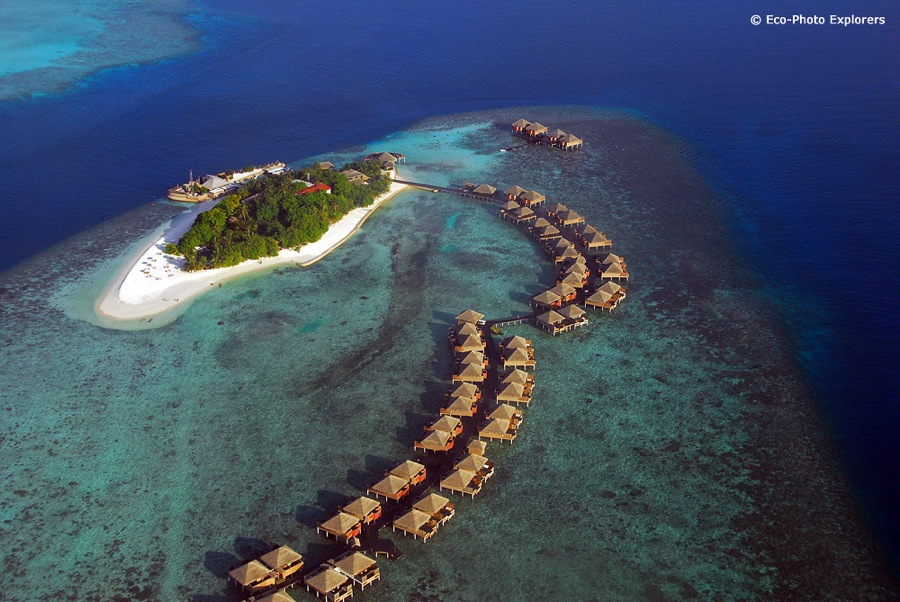
The Maldives are spread across a large swath of ocean like so many jewels cast into the sea. (Click to see larger).
The Republic of the Maldives is a small Islamic nation of roughly 1190 tiny islands and 270,000 people stretched across a vast expanse of the Indian Ocean just south and west of India. The low-lying coral islands, none reaching higher than a few meters above sea level, and innumerable reefs form 26 atolls and the total territorial area is 115,300 square kilometers…of which only 298 square kilometers is actually dry land. Many of the islands are uninhabited. Many are home to the residents of the Maldives and are difficult to visit for tourists. But a number of other islands have been set aside for tourism, each home to a single resort on a small island in one of the many atolls of the Maldives.
Words and photos by Michael Salvarezza and Christopher P. Weaver
Many divers come to the Maldives looking for live-aboard adventures. With so much ocean to explore, who can blame them? For those who are seeking shipboard adventures, the Maldives offers several well-appointed and well-known live-aboards that operate in these waters. But for some, the idea of spending time in a luxury resort with access to world-class diving just minutes away from spectacular beaches and comfortable accommodations is an unbeatable combination.
Our adventure in the Maldives centered on the Ari Atoll, with a home base on Rangali Island and the Conrad Resort. After arriving in the international airport on Male, we quickly boarded a seaplane for a quick 30-minute fight to Rangali. Along the way, we got spectacular views of the islands, reefs and atolls of this very special place. Like a necklace of fine jewels, the islands dot the blue water below and each one looks more inviting than the next. Visitors take speedboats or seaplanes to their respective resorts. We were fortunate that a seaplane is necessary to get to Rangali, which provided us a unique perspective on the islands and, for us, was the much-preferred option!
After settling in and getting a good night’s sleep in an over-water bungalow, it was time to go diving. Our first dive was on the Angaga Thila, a short boat ride away aboard a traditional Dhoni, which was set up as a well-equipped dive boat. A “Thila” is a coral formation that rises sharply from the atoll floor and reaches within 5-15 meters of the surface. Clouds of colorful reef fish swarm the tops of these coral formations while the sides of these small mountains provide numerous nooks and crannies for more secretive marine life. We spotted schools of Fairy Basslets in blazing reds, oranges and purples flitting among the coral fingers, inspiring us to refer to these waters as “The Rainbow Sea”. In addition, Blue Fusiliers patrolled the reefs, swooping along and paying us divers almost no mind. Deeper along the reef walls we found Parrotfish, Groupers and Moray Eels, all warily casting an eye to the strange bubble blowing visitors swimming through their homes.
Fenfushi Thila is another spectacular coral jungle, complete with cleaning stations, resident Moray Eels and numerous Anemones, each with a resident family of photogenic Anemonefish. Here, we were mesmerized as gaudily colored Surgeonfish swam by, the Powder-Blue Surgeonfish perhaps the most frequently seen in these waters.
Our scuba dives in the Air Atoll also took us to the famous Manta Point, where we encountered Manta Rays hovering above in the currents. We were also very fortunate to swim with a juvenile Whale Shark for a few fleeting moments before he descended out of view, even though we were here at a time when Whale Sharks are not very commonly seen.
At Mandhoo Corner, a curve in the fringing reef near Mandhoo Island, our macro photography interests exploded as we spotted an Ornate Ghost Pipefish hiding expertly among the fronds of a sea fan. Without the whoops and hollers of the dive guide, we would never have seen it! Later, as we descended along the reef, we encountered a sedentary Leaf Fish and managed to pop-off several photos before moving along down the reef.
On a night dive at Mirhi Thila, we saw Basket Stars and Feather Stars in abundance, along with a large peacock Mantis Shrimp. These crustaceans are perfectly suited for their habitat and can literally smash aquarium glass with their modified front claws.
Looking very much like “The Blob” from the movie of the same name, the Maldives Sponge Snail is endemic to this region and we spotted a nice specimen as we neared the end of our night dive.
Rangali Outside was the name of the reef on the outside of the fringing coral reef near Rangali Island, and it was here that we photographed Sweetlips, Grouper and myriad species of wrasse. In the Maldives, Butterflyfish and Angelfish come in the most outrageous of colors and designs and all were on prominent display on these dives.
Through a week of diving, we visited shipwrecks, Thilas, walls and other coral mazes filled with abundant marine life. Lionfish, Soldierfish, Pufferfish and many other species of intriguing fish kept our cameras busy and our memory cards full.
Resort diving in the Maldives does not come at the expense of great diving. Indeed, divers can enjoy world class diving along spectacular coral jungles while also drinking in the comfort and beauty of the island based resorts. Most of the dives are done as two-tank excursions, although an occasional all-day 3-tank diving safari is offered along with shorter one-tank trips and night dives.
The best months for diving in the Maldives are January through April when the islands are blessed with fine weather and terrific visibility. Once the rainy season starts in May, clouds and storms are frequent all the way through September, with many days of diving lost to rough conditions on the water. October and November have calm weather but the waters are cloudy with annual plankton blooms. These months offer reduced visibility in exchange for the opportunity to see larger pelagics such as Whale Sharks and Manta Rays. In all seasons, divers should be prepared for strong currents on many dives.
The Maldive Islands have been at the forefront of environmental protection. Recently, Mohamed Aslam, the Environment Minister of the Maldives, announced the protection of coral reefs and waters in and around Baa atoll Hanifaru, Baa atoll An’gafaru and South Ari atoll Maamigili, all with a focus on providing protection for sharks and other critically threatened species. The reefs here are under siege, as they are the world over, from rising water temperatures and other pressures. For divers who visit today, however, these reefs remain a rainbow of brilliant and vibrant color and are home to a fascinating array of life.
Sadly, the Maldive Islands are one of the most vulnerable nations on earth to the effects of climate change. With low lying coral islands comprising the entirety of this nation, rising sea levels will someday swallow up this pristine paradise. Indeed, the government has already been looking for land to purchase for a future relocation of its residents when that time comes.
So, for scuba divers, the time is now! If you are looking for exciting diving adventures along with a dash of decadent pleasure, consider one of the Maldives’ many luxurious island based resorts for a diving vacation unlike any other. You’ll be pleased that you did.
Getting There
The only international airport is located on the main island of Male. It is serviced with direct flights from Dubai, Colombo (Sri Lanka) and a few other destinations.
Visitors will next board speedboats or seaplanes depending on the location and distance of the resort. Check with your resort for arrangements. Many of the upscale resorts have comfortable lounges at the main airport where visitors can relax while waiting for transfers. Tours of Male can be arranged if the transfer time is longer than a few hours in duration.
A valid passport is required for entry. Visas are not required.
Baggage
Baggage allowances vary for each international carrier so check before you leave. There are strict weight limits on the seaplanes so check with your carriers before departing.
Weather
The Maldives has an equatorial tropical climate. December through April is the dry season. February through April is the hottest time of the year, with temperatures in the 80s and 90s Fahrenheit each day. May through November is the rainy season.
Currency
The local currency is the rufiya (Rf) but US Dollars and Euros are generally accepted at all resorts.
Electricity
Power voltage used in the Maldives is 220 Volts to 240 Volts (50 Hz). Be sure to double-check your appliance’s compatibility before plugging them in. Converters / adaptors are usually available upon request at your hotel front desk.
Customs
The Republic of the Maldives is a strict Islamic nation. Alcohol, firearms, pornography, pork, narcotics and “idols of worship” are among the prohibited items.
Because of the concern over evangelists spreading their beliefs within the country, attention is paid to religious items. A small crucifix, worn as jewelry, is unlikely to be a problem but a suitcase with several Bibles will likely create concern!
Words and photos by Michael Salvarezza and Christopher P. Weaver
All contents are ©2013 and may not be reproduced in any format without prior express permission.
Photo Gallery (Click a photo to see full size).
- A juvenile Blacktip Reef Shark patrols the shallows.
- Divers prepare for their next adventure.
- Paradise in the Maldives.
- These fish know to give this shark a wide bearth.
- The capital of the Maldives, Male, from the air.
- A Dhoni equipped for diving.
- A Dhoni equipped for diving.
- An idyllic Maldivian beach.
- Who wouldn’t dream of being here?
- The Maldives are spread across a large swath of ocean like so many jewels cast into the sea. (Click to see larger).
- The Maldives are spread across a large swath of ocean like so many jewels cast into the sea.
- A Honey Combed Moray greets the camera.
- A Leaf Fish does its best to hide in the reef.
- Coral outcroppings are steps away from your room.
- A Mantis Shrimp defends its lair.
- A Giant Squirrelfish gets his whiskers cleaned.
- A beautiful red Fire Goby.
- A diver exploring the rainbow reefs of the Maldives.
- A school of White_Edge Soldierfish.
- Giant Squirrelfish can be approached quite easily.
- A Jewel Fairy Basslet flashes its brilliant colors.
- A Black Spotted Puffer fish casts a wary eye from underneath a rock ledge.
- Powder Blue Surgeonfish are a striking flash of color along the reefs.
- Venomous Lionfish are seen frequently along the reefs.
- The ghostly reminder of a past history of fishing for a sunken ship.
- Clams of al sizes can be found along the reefs.
- A Coral Grouper opens wide for a teeth cleaning.
- Tucked into fingers of corals are communities of brilliantly colored fish.
- The reefs of the Maldives explode in colors.

